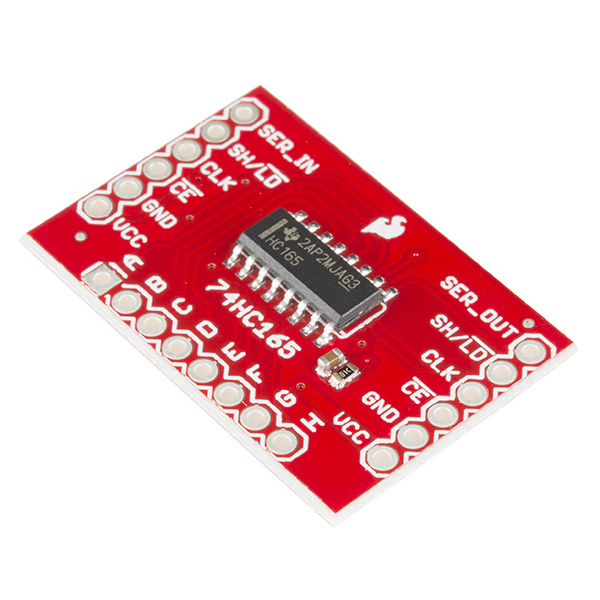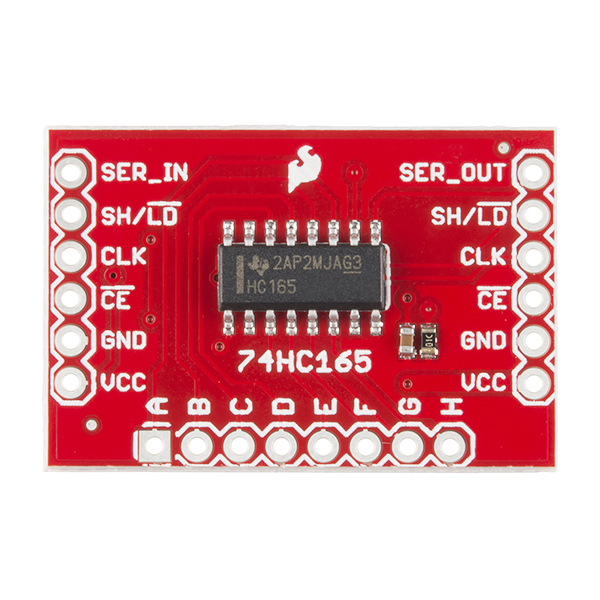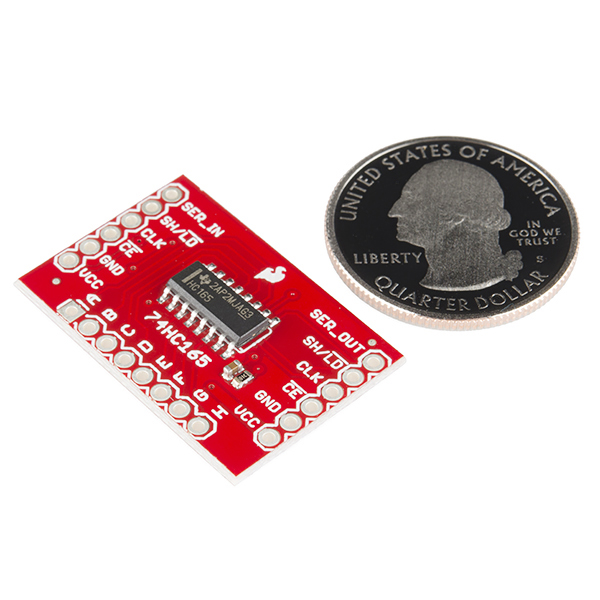SparkFun Shift-In Breakout - SN74HC165
The SN74HC165N is a neat little IC that will take an input of up to 8 parallel lines and produce a single, serial output. It's a great way to increase the number of inputs on a microcontroller.
This breakout makes it easy to prototype using the 74HC165 by breaking out all of the pins you need to standard 0.1" spaced headers. We've also lined up the data and power pins so that you can easily make chains of them and expand the number of outputs under your control!
This chip works with a voltage supply anywhere in the range of 2-6VDC, and at clock frequencies of up to 29MHz (@6VDC).
- Wide Operating Voltage Range of 2 V to 6 V
- Parallel-to-Serial Data Conversion
- Outputs Can Drive Up To 10 LSTTL Loads
- Low Power Consumption, 80-μA Max ICC
- ±4mA Output Drive at 5 V
- Low Input Current of 1 μA Max
- Complementary Outputs
- Direct Overriding Load (Data) Inputs
- Gated Clock Inputs
- 0.1" Spaced Headers
- [Schematic](https://cdn.sparkfun.com/datasheets/BreakoutBoards/SN74HC165 Shift-In Breakout-v12.pdf)
- [Eagle Files](https://cdn.sparkfun.com/datasheets/BreakoutBoards/SN74HC165 Shift-In Breakout-v12.zip)
- Datasheet (SN74HC165N)
- Arduino Example
- GitHub (Design Files)
SparkFun Shift-In Breakout - SN74HC165 Product Help and Resources
Core Skill: Soldering
This skill defines how difficult the soldering is on a particular product. It might be a couple simple solder joints, or require special reflow tools.
Skill Level: Noob - Some basic soldering is required, but it is limited to a just a few pins, basic through-hole soldering, and couple (if any) polarized components. A basic soldering iron is all you should need.
See all skill levels
Core Skill: Programming
If a board needs code or communicates somehow, you're going to need to know how to program or interface with it. The programming skill is all about communication and code.
Skill Level: Rookie - You will need a better fundamental understand of what code is, and how it works. You will be using beginner-level software and development tools like Arduino. You will be dealing directly with code, but numerous examples and libraries are available. Sensors or shields will communicate with serial or TTL.
See all skill levels
Core Skill: Electrical Prototyping
If it requires power, you need to know how much, what all the pins do, and how to hook it up. You may need to reference datasheets, schematics, and know the ins and outs of electronics.
Skill Level: Rookie - You may be required to know a bit more about the component, such as orientation, or how to hook it up, in addition to power requirements. You will need to understand polarized components.
See all skill levels
Comments
Looking for answers to technical questions?
We welcome your comments and suggestions below. However, if you are looking for solutions to technical questions please see our Technical Assistance page.
Customer Reviews
5 out of 5
Based on 2 ratings:
Extending inputs
Tiny sized and very good quality pcb. Excellent for extending inputs when arbitrary combination of bits are required.
very useful
time saver,





Example tutorial expanding Analog Device's ADALM1000 digital I/O pins and Python => https://ez.analog.com/community/university-program/blog/2015/09/09/expanding-the-number-of-adalm1000-digital-inputs-and-outputs.
To be honest, I think this is a pointless product, I can't see how it offers customers a valuable product.
You can just go to Digi-Key, or anywhere, and buy your SN74HC165 in a through-hole 16-pin DIP. (They cost 52 cents in single quantity, at Digi-Key.)
Sure, if you've got an IC that is only available as a tiny surface-mount QFN or similar, selling a breakout board product is useful and sensible. But for a basic chip such as a shift register that IS easily available in DIP I can't see the point of taking the SOIC version of the chip and selling it on a breakout PCB to give you the same footprint as a DIP chip that you can use on a breadboard just like any DIP chip.
You're spending the time and effort laying out these boards, getting the PCBs made, getting the headers and SOIC chips and manufacturing them... for no reason, really.
Yes, Sparkfun doesn't carry the DIP chips, but Sparkfun could easily do so if you chose to.
Well, I guess grouping the serial pins and parallel output pins in a grouped way to make it easy to daisy-chain multiple boards by just plugging together modules could be an advantage in some cases, but not every DIP chip in the world needs a Sparkfun-style breakout board with rearranged pin groupings plus markup.
And the two vertical rows plus horizontal row of pins would seem to make this difficult or impossible to use in a breadboard if you want all pins connected, without shorting out one of the rows of pins. for that application, best to use an ordinary DIP chip.
i like them. i hope they keep stocking // making these breakout boards!
It may not be for everyone, but I like having chips in my prototyping box that have the pinout right there with it. It might not seem like it saves a lot of time, but I find it SUPER convenient when you have more than a couple ICs in your project. Having a header optimized for daisy chaining is also nice.
PS. The two headers along the sides get male pins that plug into the breadboard, while the third row gets a female header on top for plugging wires into it. Shorting really isn't an issue. Come on, man. I feel like you're just TRYING to be difficult. :P
For those landing here from BOB-11512 (v1.0-ish* of this board), v1.2 fixes the "SER_IN and SER_OUT labels are swapped" issue with that was present in v1.0-ish . Note that this appears to be fixed not by changing the labeling, but by swapping the pins, so the two boards are not pin-compatible; the pin that was SER_IN and erroneously labeled SER_OUT is now actually SER_OUT, and vice versa.
*The Eagle files from BOB-11512 are actually v1.1 with the issue already corrected (older 'v1.1' is in the Github repo history). The easiest way to see which board version you have is to check the bottom of the board, where the version number is written on the copper layer. Alternatively, check the vias around the IC. If there's a via by pin 9, you've got v1.0, and if there's a via connected via a longer trace to pin 10, you've got v1.1 / v1.2.
Thanks!!! Very helpful note - should be in the above product description!
Just wished I had read it earlier... lost a couple of boards futzing with the BOB-11512s
Are these chips not available in DIPs any more?
No, we don't currently offer them in a DIP package.